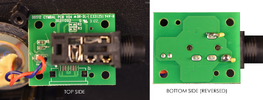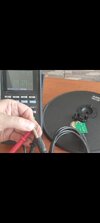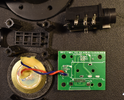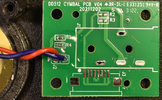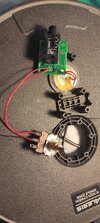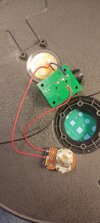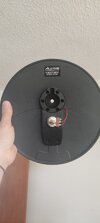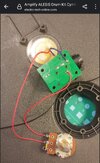Menticol
Active Member
Hello guys!
I'm having some issues with my drum kit. The drum kit works as follows: The drum kit has a piezoelectric sensor attached to the pad (see attached photos). When the pad is hit the drum's "brain" module receives a pulse from the piezo sensor, presumably after passing through a voltage divider, and plays a sound. The volume of the played sound is somewhat proportional to the energy of the impact against the pad. The played sound is a pre-recorded file and has no resemblance of the received impact signal.
The problem is that the cymbals of my electronic drum kit are much quieter than the snare drum, and do require an excessive force to play at a reasonable volume, making the playing experience very strange.
Since the "brain" of my drum kit doesn't provide a way to adjust the sensitivity of each pad, I was thinking of putting a little OP amp between the piezoelectric sensor and the brain, with a potentiometer to adjust the gain.
I bought a TL082 Opamp and tried to follow another post on this forum where the OP also was trying to amplify a piezo signal. But my electronics knowledge is very basic and I'm not sure how to calculate the adequate resistor values to reach the specific gain/voltage, or how to run the TL082 on a single rail supply and not have the risk of frying the drumkit brain (the brain uses a singe rail 12V supply).
Attached is the output of the cymbal connected to an oscilloscope, showing the quieter signal and how much gain would be needed.
Any tips will be very appreciated



I'm having some issues with my drum kit. The drum kit works as follows: The drum kit has a piezoelectric sensor attached to the pad (see attached photos). When the pad is hit the drum's "brain" module receives a pulse from the piezo sensor, presumably after passing through a voltage divider, and plays a sound. The volume of the played sound is somewhat proportional to the energy of the impact against the pad. The played sound is a pre-recorded file and has no resemblance of the received impact signal.
The problem is that the cymbals of my electronic drum kit are much quieter than the snare drum, and do require an excessive force to play at a reasonable volume, making the playing experience very strange.
Since the "brain" of my drum kit doesn't provide a way to adjust the sensitivity of each pad, I was thinking of putting a little OP amp between the piezoelectric sensor and the brain, with a potentiometer to adjust the gain.
I bought a TL082 Opamp and tried to follow another post on this forum where the OP also was trying to amplify a piezo signal. But my electronics knowledge is very basic and I'm not sure how to calculate the adequate resistor values to reach the specific gain/voltage, or how to run the TL082 on a single rail supply and not have the risk of frying the drumkit brain (the brain uses a singe rail 12V supply).
Attached is the output of the cymbal connected to an oscilloscope, showing the quieter signal and how much gain would be needed.
Any tips will be very appreciated
Last edited:
